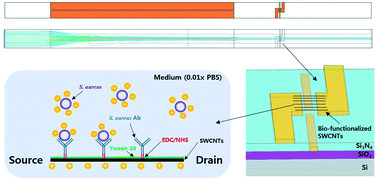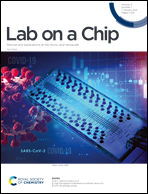Integrated microfluidic platform with electrohydrodynamic focusing and a carbon-nanotube-based field-effect transistor immunosensor for continuous, selective, and label-free quantification of bacteria†
Abstract
Electrokinetic technologies such as AC electro-osmosis (EO) and dielectrophoresis (DEP) have been used for effective manipulation of bacteria to enhance the sensitivity of an assay, and many previously reported electrokinetics-enhanced biosensors are based on stagnant fluids. An effective region for positive DEP for particle capture is usually too close to the electrode for the flowing particles to move toward the detection zone of a biosensor against the flow direction; this poses a technical challenge for electrokinetics-assisted biosensors implemented within pressure-driven flows, especially if the particles flow with high speed and if the detection zone is small. Here, we present a microfluidic single-walled carbon nanotube (SWCNT)-based field-effect transistor immunosensor with electrohydrodynamic (EHD) focusing and DEP concentration for continuous and label-free detection of flowing Staphylococcus aureus in a 0.01× phosphate buffered saline (PBS) solution. The EHD focusing involved AC EO and negative DEP to align the flowing particles along lines close to the bottom surface of a microfluidic channel for facilitating particle capture downstream at the detection zone. For feasibility, 380 nm-diameter fluorescent beads suspended in 0.001× PBS were tested, and 14.6 times more beads were observed to be concentrated in the detection area with EHD focusing. Moreover, label-free, continuous, and selective measurement of S. aureus in 0.01× PBS was demonstrated, showing good linearity between the relative changes in electrical conductance of the SWCNTs and logarithmic S. aureus concentrations, a capture/detection time of 35 min, and a limit of detection of 150 CFU mL−1, as well as high specificity through electrical manipulation and biological interaction.



 Please wait while we load your content...
Please wait while we load your content...